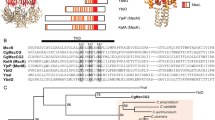Abstract
The ubiquity of mechanosensitive (MS) ion channels set off a search for their functional homologues in archaea, the third domain of life. A new MS channel was identified in the archaeon Methanococcus jannaschii by using the TM1 transmembrane domain of the bacterial MS channel of large conductance, MscL, as a genetic probe to search the archaeal genomic database for MS channel homologues. The hypothetical protein MJ0170 (MscMJ) was found to harbor two MscL-like TM1 structural motifs and showed a high degree of sequence and secondary structure conservation with MscS (YggB) homologues. The alignment of sequences of MscL, MscS and MscMJ homologues further revealed that bacterial and archaeal channels form a phylogenetic tree composed of three main branches and share a common ancestral origin. This suggests the evolution of prokaryotic MS channels via gene duplication of a MscL-like progenitor gene followed by divergence, further indicating that the common ancestor of the prokaryotic MS channels most likely resembled MscL. When expressed in E. coli and functionally examined by the patch clamp, the MscMJ protein behaved as a MS channel with a conductance of 270 pS in 200 mM KCl and a cation selectivity (P K/P Cl) of approximately 6. The structural and functional homologue of MscMJ, MscMJLR, was identified as a second type of MS channel in M. jannaschii. The channel has a conductance of approximately 2 nS, rectifies with voltage and shares cation selectivity with MscMJ. The stoichiometry of both types of MS channels revealed that the free energy of activation, ΔG 0≈7kT, obtained for MscMJ matches the one calculated for MscS, ΔG 0≈5kT, whereas the free energy of activation of ΔG 0≈18kT of MscMJLR resembles more the ΔG 0=14–19kT reported for MscL. The presence of two types of MS channels discovered in the cell envelope of M. jannaschii indicates that multiplicity of MS channels in prokaryotes is a necessary element for their survival in the habitats frequently challenged by sudden changes in osmolarity. Further functional and phylogenetic study of MS channels from all three domains of the universal phylogenetic tree may help to understand the evolution and common biophysical principles that govern mechanosensory transduction.
Similar content being viewed by others
Author information
Authors and Affiliations
Additional information
Revised version: 11 April 2001
Electronic Publication
Rights and permissions
About this article
Cite this article
Kloda, A., Martinac, B. Mechanosensitive channels of bacteria and archaea share a common ancestral origin. Eur Biophys J 31, 14–25 (2002). https://doi.org/10.1007/s002490100160
Received:
Accepted:
Published:
Issue Date:
DOI: https://doi.org/10.1007/s002490100160




